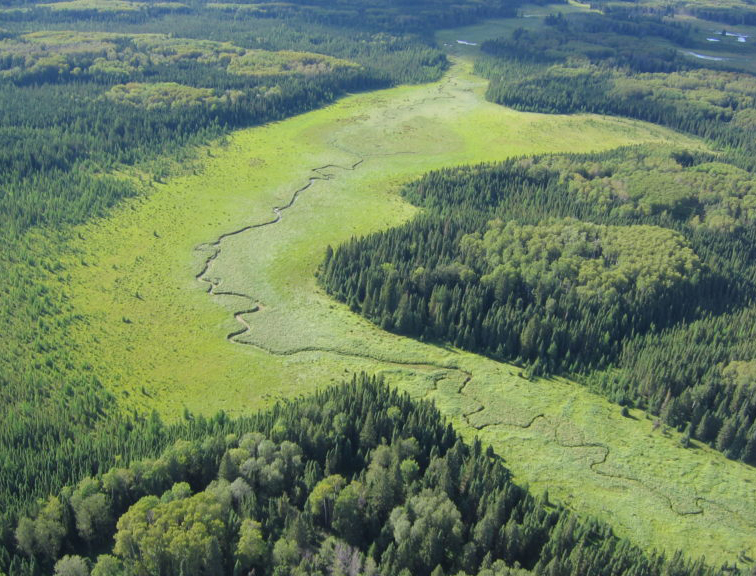Guest Blogger
Dr. Mark Johnston, Scientist, SRC’s Environment Division
Here’s a fact about wetlands that many Canadians may find surprising: according to the Geological Survey of Canada, the peat in Canada’s wetlands stores almost 60 percent of all the carbon stored in soils across the country.
Further, the 147-billion tonnes of carbon stored in Canadian wetlands is more than 900 times the annual CO2 emissions from all industrial activity in Canada.

Boreal Wetland Complex (part of the project study area). Photo: Ducks Unlimited Canada
This tremendous ability to store carbon, while supporting habitat for numerous animal and plant species, makes Canada’s wetlands critically important to our natural environment. And the more we learn about these wetlands, the better we’ll be able to conserve them.
Carbon Measurement in Wetlands
We know that wetlands, both in Canada and globally, store huge amounts of carbon. While we understand it’s important to store carbon, reduce CO2 emissions and mitigate climate change, we’re also aware that we need a greater understanding of how best to measure the carbon stored in wetlands.
In terms of carbon management generally, it’s crucial that land managers understand how much carbon is stored both in trees and soil. Today, methods and tools for carbon measurement are well established for upland forests because these types of dry forests have been studied for decades. By comparison, we know much less about carbon measurement in wetlands, where trees are smaller and areas are water saturated and difficult to operate in.
That’s why the Saskatchewan Research Council has teamed up with the Sustainable Forestry Initiative (SFI), Louisiana-Pacific Canada (LP) and Spruce Products Ltd (both SFI Program Participants), and Ducks Unlimited Canada in developing a rapid assessment tool to measure carbon storage in boreal forest wetlands.

Field crew collects data at sample plot. Photo: Ducks Unlimited Canada
Creating a Field-Ready Protocol for Industry
There’s been little motivation in the past for forest managers to go out into the field and quantify carbon stored in Canadian wetlands, due to difficulties in sampling waterlogged areas and also that, in general, these areas are not managed. And yet the wetland carbon values from the Geological Survey of Canada show it’s crucial we understand carbon stored in wetlands much, much better. Forest managers are now taking a more holistic ecosystem-based view of their landscapes and need to know how wetlands and uplands are related, and how forestry activities can affect wetland values such as carbon storage.
Unlike upland forests where carbon storage is in the upper 30 centimeters of soil, wetlands are a three-dimensional system, and carbon in wetlands can be stored two or three metres deep, complicating carbon measurement.
The goal of our project is to develop a rapid protocol that is usable by forestry professionals in the real world to get credible, reasonably accurate estimates of carbon storage in wetlands. That means not only developing the assessment steps, but testing them in the field with LP and Spruce Products near Swan River in Western Manitoba. A crew was in the field last summer, taking measurements of peat depth and extracting peat cores in order to complete the required calculations. We also used this as an opportunity to refine the protocol during the first two weeks of sampling.

Peat core collected for lab analysis to determine carbon content. Photo: Ducks Unlimited Canada
Next Steps
The LP crew wrapped up the sampling exercise in September and several hundred peat core samples were sent to the peatland lab at the University of Brandon to be analyzed for carbon content and bulk density. These values, along with peat depth, will be used to calculate the total mass of peat carbon in each of the 28 wetlands sampled. The protocol should apply widely to wetlands in the boreal region, and can be modified to apply to other SFI-certified landscapes across Canada and the U.S.
On top of this, we’re also using published data from wetlands in other parts of the boreal forest so that our team can conduct a rapid assessment of carbon in above-ground vegetation that occurs in the wetlands. Adding together the carbon estimates from peat and vegetation will give us a picture of total carbon storage in the Manitoba boreal forest wetlands.
As collaborations go, this one is especially strong. I’m thankful the Sustainable Forestry Initiative has seen value in supporting our work through its Conservation Grants Program, while LP and Spruce Products have provided access and resources on the forest licenses they manage. Ducks Unlimited Canada used their boreal wetland inventory to select wetland sample sites and will be including the results of this work in its wetlands carbon store mapping project.
We’re only in year one of this three-year project, and the project collaborators can see the value of the work emerging already. For the project collaborators, the issue is simple: there’s a tremendous amount of carbon in our wetlands. So it follows that wetland conservation is important – not only for carbon, but for other environmental values like biodiversity and water quality.
And accomplishing that takes good science.
Dr. Mark Johnston is a Distinguished Scientist in SRC’s Environment Division. He has worked at SRC since 2001 in the areas of forest ecology and climate change. Most recently, he helped lead a national study on the vulnerability of Canada’s forest sector to the impacts of climate change. He continues to work with the forest industry and government to assist them in understanding climate change impacts and how they can adapt to these changes.
This blog was re-posted with permission from SRC’s blog.
